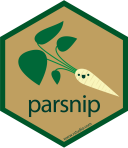03:00
3 - What makes a model?
Machine learning with tidymodels
Your turn

How do you fit a linear model in R?
How many different ways can you think of?
lmfor linear modelglmfor generalized linear model (e.g. logistic regression)glmnetfor regularized regressionkerasfor regression using TensorFlowstanfor Bayesian regressionsparkfor large data sets
To specify a model ![]()
- Choose a model
- Specify an engine
- Set the mode
To specify a model ![]()
To specify a model ![]()
- Choose a model
- Specify an engine
- Set the mode
To specify a model ![]()
To specify a model ![]()
To specify a model ![]()
- Choose a model
- Specify an engine
- Set the mode
To specify a model ![]()
To specify a model ![]()
All available models are listed at https://www.tidymodels.org/find/parsnip/
To specify a model ![]()
- Choose a model
- Specify an engine
- Set the mode
Your turn

Run the tree_spec chunk in your .qmd.
Edit this code to use a different model.
05:00
All available models are listed at https://www.tidymodels.org/find/parsnip/
Models we’ll be using today
- Logistic regression
- Decision trees
Logistic regression
Logistic regression
Logistic regression
- Logit of outcome probability modeled as linear combination of predictors:
\(log(\frac{p}{1 - p}) = \beta_0 + \beta_1\cdot \text{distance}\)
- Find a sigmoid line that separates the two classes
Decision trees
Decision trees
Series of splits or if/then statements based on predictors
First the tree grows until some condition is met (maximum depth, no more data)
Then the tree is pruned to reduce its complexity
Decision trees
All models are wrong, but some are useful!
Logistic regression
Decision trees
A model workflow
Workflows bind preprocessors and models

What is wrong with this?

Why a workflow()? ![]()
- Workflows handle new data better than base R tools in terms of new factor levels
- You can use other preprocessors besides formulas (more on feature engineering tomorrow!)
- They can help organize your work when working with multiple models
- Most importantly, a workflow captures the entire modeling process:
fit()andpredict()apply to the preprocessing steps in addition to the actual model fit
A model workflow ![]()
![]()
tree_spec <-
decision_tree() %>%
set_mode("classification")
tree_spec %>%
fit(tip ~ ., data = taxi_train)
#> parsnip model object
#>
#> n= 7045
#>
#> node), split, n, loss, yval, (yprob)
#> * denotes terminal node
#>
#> 1) root 7045 2069 yes (0.70631654 0.29368346)
#> 2) company=Chicago Independents,City Service,Sun Taxi,Taxicab Insurance Agency Llc,other 4328 744 yes (0.82809612 0.17190388)
#> 4) distance< 4.615 2365 254 yes (0.89260042 0.10739958) *
#> 5) distance>=4.615 1963 490 yes (0.75038207 0.24961793)
#> 10) distance>=12.565 1069 81 yes (0.92422825 0.07577175) *
#> 11) distance< 12.565 894 409 yes (0.54250559 0.45749441)
#> 22) company=Chicago Independents,Sun Taxi,Taxicab Insurance Agency Llc 278 71 yes (0.74460432 0.25539568) *
#> 23) company=City Service,other 616 278 no (0.45129870 0.54870130)
#> 46) distance< 7.205 178 59 yes (0.66853933 0.33146067) *
#> 47) distance>=7.205 438 159 no (0.36301370 0.63698630) *
#> 3) company=Flash Cab,Taxi Affiliation Services 2717 1325 yes (0.51232978 0.48767022)
#> 6) distance< 3.235 1331 391 yes (0.70623591 0.29376409) *
#> 7) distance>=3.235 1386 452 no (0.32611833 0.67388167)
#> 14) distance>=12.39 344 90 yes (0.73837209 0.26162791) *
#> 15) distance< 12.39 1042 198 no (0.19001919 0.80998081) *A model workflow ![]()
![]()
tree_spec <-
decision_tree() %>%
set_mode("classification")
workflow() %>%
add_formula(tip ~ .) %>%
add_model(tree_spec) %>%
fit(data = taxi_train)
#> ══ Workflow [trained] ════════════════════════════════════════════════
#> Preprocessor: Formula
#> Model: decision_tree()
#>
#> ── Preprocessor ──────────────────────────────────────────────────────
#> tip ~ .
#>
#> ── Model ─────────────────────────────────────────────────────────────
#> n= 7045
#>
#> node), split, n, loss, yval, (yprob)
#> * denotes terminal node
#>
#> 1) root 7045 2069 yes (0.70631654 0.29368346)
#> 2) company=Chicago Independents,City Service,Sun Taxi,Taxicab Insurance Agency Llc,other 4328 744 yes (0.82809612 0.17190388)
#> 4) distance< 4.615 2365 254 yes (0.89260042 0.10739958) *
#> 5) distance>=4.615 1963 490 yes (0.75038207 0.24961793)
#> 10) distance>=12.565 1069 81 yes (0.92422825 0.07577175) *
#> 11) distance< 12.565 894 409 yes (0.54250559 0.45749441)
#> 22) company=Chicago Independents,Sun Taxi,Taxicab Insurance Agency Llc 278 71 yes (0.74460432 0.25539568) *
#> 23) company=City Service,other 616 278 no (0.45129870 0.54870130)
#> 46) distance< 7.205 178 59 yes (0.66853933 0.33146067) *
#> 47) distance>=7.205 438 159 no (0.36301370 0.63698630) *
#> 3) company=Flash Cab,Taxi Affiliation Services 2717 1325 yes (0.51232978 0.48767022)
#> 6) distance< 3.235 1331 391 yes (0.70623591 0.29376409) *
#> 7) distance>=3.235 1386 452 no (0.32611833 0.67388167)
#> 14) distance>=12.39 344 90 yes (0.73837209 0.26162791) *
#> 15) distance< 12.39 1042 198 no (0.19001919 0.80998081) *A model workflow ![]()
![]()
tree_spec <-
decision_tree() %>%
set_mode("classification")
workflow(tip ~ ., tree_spec) %>%
fit(data = taxi_train)
#> ══ Workflow [trained] ════════════════════════════════════════════════
#> Preprocessor: Formula
#> Model: decision_tree()
#>
#> ── Preprocessor ──────────────────────────────────────────────────────
#> tip ~ .
#>
#> ── Model ─────────────────────────────────────────────────────────────
#> n= 7045
#>
#> node), split, n, loss, yval, (yprob)
#> * denotes terminal node
#>
#> 1) root 7045 2069 yes (0.70631654 0.29368346)
#> 2) company=Chicago Independents,City Service,Sun Taxi,Taxicab Insurance Agency Llc,other 4328 744 yes (0.82809612 0.17190388)
#> 4) distance< 4.615 2365 254 yes (0.89260042 0.10739958) *
#> 5) distance>=4.615 1963 490 yes (0.75038207 0.24961793)
#> 10) distance>=12.565 1069 81 yes (0.92422825 0.07577175) *
#> 11) distance< 12.565 894 409 yes (0.54250559 0.45749441)
#> 22) company=Chicago Independents,Sun Taxi,Taxicab Insurance Agency Llc 278 71 yes (0.74460432 0.25539568) *
#> 23) company=City Service,other 616 278 no (0.45129870 0.54870130)
#> 46) distance< 7.205 178 59 yes (0.66853933 0.33146067) *
#> 47) distance>=7.205 438 159 no (0.36301370 0.63698630) *
#> 3) company=Flash Cab,Taxi Affiliation Services 2717 1325 yes (0.51232978 0.48767022)
#> 6) distance< 3.235 1331 391 yes (0.70623591 0.29376409) *
#> 7) distance>=3.235 1386 452 no (0.32611833 0.67388167)
#> 14) distance>=12.39 344 90 yes (0.73837209 0.26162791) *
#> 15) distance< 12.39 1042 198 no (0.19001919 0.80998081) *Your turn

Run the tree_wflow chunk in your .qmd.
Edit this code to make a workflow with your own model of choice.
05:00
Predict with your model ![]()
![]()
How do you use your new tree_fit model?
Your turn

Run:
predict(tree_fit, new_data = taxi_test)
What do you get?
03:00
Your turn

Run:
augment(tree_fit, new_data = taxi_test)
What do you get?
03:00
The tidymodels prediction guarantee!
- The predictions will always be inside a tibble
- The column names and types are unsurprising and predictable
- The number of rows in
new_dataand the output are the same
Understand your model ![]()
![]()
How do you understand your new tree_fit model?
Understand your model ![]()
![]()
How do you understand your new tree_fit model?
You can extract_*() several components of your fitted workflow.
Understand your model ![]()
![]()
How do you understand your new tree_fit model?
You can use your fitted workflow for model and/or prediction explanations:
- overall variable importance, such as with the vip package
- flexible model explainers, such as with the DALEXtra package
Learn more at https://www.tmwr.org/explain.html
Your turn

Extract the model engine object from your fitted workflow.
⚠️ Never predict() with any extracted components!
05:00
Deploy your model ![]()
Deploying a model ![]()
How do you use your new tree_fit model in production?
Learn more at https://vetiver.rstudio.com
Deploy your model ![]()
How do you use your new model tree_fit in production?
library(plumber)
pr() %>%
vetiver_api(v)
#> # Plumber router with 2 endpoints, 4 filters, and 1 sub-router.
#> # Use `pr_run()` on this object to start the API.
#> ├──[queryString]
#> ├──[body]
#> ├──[cookieParser]
#> ├──[sharedSecret]
#> ├──/logo
#> │ │ # Plumber static router serving from directory: /Library/Frameworks/R.framework/Versions/4.2-arm64/Resources/library/vetiver
#> ├──/ping (GET)
#> └──/predict (POST)Learn more at https://vetiver.rstudio.com
Your turn

Run the vetiver chunk in your .qmd.
Check out the automated visual documentation.
05:00
The whole game - status update



